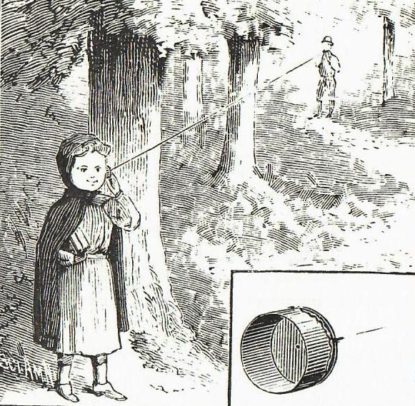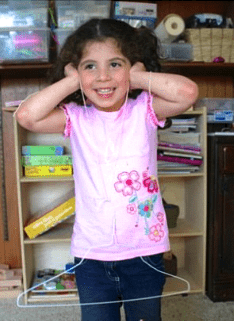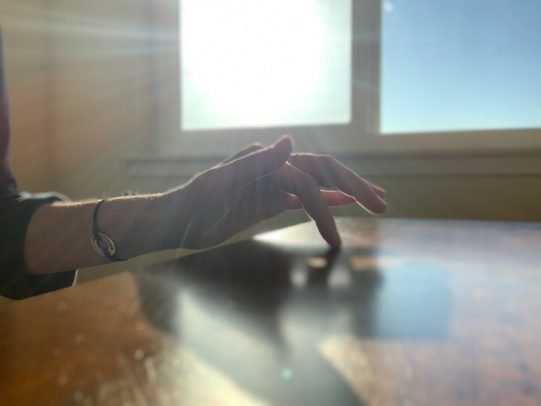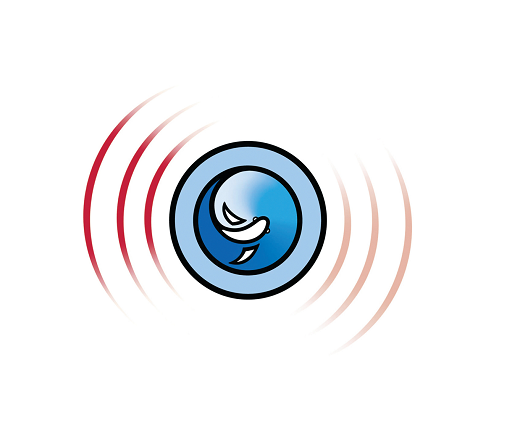Sound Transmission Experiments (Ages 5+)
When we think of sound, we usually think of sound in air, because we usually hear sound in air through our ears – which are specifically adapted to hear airborne sound. But if you were a termite, or a mole, you might be hearing sounds in wood, or soil, not through ears, but through your feet! And if you were a fish, or a whale, where do you think you might hear sounds?
What is perceived as sound is actually acoustical energy that can transmit, or propagate through any material. Ocean Conservation Research is focused on sounds (and noise) in the ocean. Because sunlight does not penetrate into the ocean depths, ocean animals rely on sound more than they rely on light to sense their surroundings, so sound propagation (and transmission) in seawater is central to our work.
These experiments take advantage of the sound propagation characteristics of various materials under various conditions.
Coat-Hanger and String-A-Phone
Physics at Your Desk: Drumming Finger
Seeing Sound Experiments (Ages 10+)
Humans, along with most terrestrial animals depend on sight as well as sound to inform us of our surroundings, although we all use it differently. I have found that some people are visual-dominant, and others hearing-dominant.
There is a not uncommon neurological condition called synesthesia that enriches some people’s perceptions by letting them see colors when they hear a sound. Romantic composer Alexander Scriabin saw sound this way and shared it with his audience in his tone poem Prometheus – Poem of Fire with what was probably the first musical light show. But how else might we see sound? There happens to be tools for this – ones that translate acoustical energy into visual patterns.
Cup Telephone

Little Red Riding Hood getting long distance instructions from the Wolf.
This is a good experiment for “social distancing!” When you talk to a friend, your voices travel from your mouths through the air (a gas) to each other’s ears. What happens when you connect your mouths and ears with a piece of string (a solid)? What happens when the string is not taut, and why?
Materials for Sound Experiment
- Two paper or plastic cups (small yogurt containers are durable)
- Scissors
- String
- Tooth pick
- A friend
Procedure for Sound Experiment
- Using the point of the scissors, poke a hole in the middle of the bottom of each cup. (Depending on your age, it may be better to have an adult do this step.)
- Stand a few feet away from a friend and talk to each other in normal (not yelling) voices.
- Keep moving apart until it is hard to hear each other.
- Hold one of the cups up to your mouth and speak into it while your friend listens into the other. Now can you hear each other?
- Next cut a length of string long enough to stretch the distance between you and your friend when it was hard to hear each other.
- Poke the ends of the string through the holes in the bottoms of the cups (poke it upwards through the bottom), tie the string in a knot around a small section of the toothpick.
- Hold onto one cup, have your friend hold onto the other, and walk away until the string is taut (pulled straight, not sagging).
- Talk into one cup while your friend holds the other cup over her ear. (Remember to keep the string taut.) Switch. Now can you hear each other through the cups? (Remember to move the cups from your mouths to your ears and back depending on if you’re listening or speaking.) Why do you think attaching the cups with the string allows you to hear each other?
- More fun with this project! Try it with longer and longer pieces of string. How far apart can you get and still have the “phone” work? What if someone grabs onto the string while you’re talking?
What’s Going On
Sound from your voice propagates in air in all directions, so the acoustical energy in your voice dissipates in all directions and thus attenuates pretty rapidly. But if you capture the sound of your voice in a cup, it contains it, and the bottom of the cup acts like a drum head or diaphragm and vibrates. This vibration is transferred to the string and knotted toothpick section and transmitted down the length of the string. This in turn vibrates the bottom of the remote cup where the listener can hear the sound vibrations
Coat-Hanger and String-A-Phone

Credit: Bug and Buddy
Explore the science of sound with a just a wire hanger and some string! Can you hear the difference between materials when you knock the coat hanger against wood, brick, metal, or seat cushions? Why would that be?
Materials for Sound Experiment
- Wire hanger
- String
Procedure for Sound Experiment
- Tie the hook of a wire hanger to the center of a large piece of string. (About 3 feet long)
- Stretch the string over the tips of your index fingers.
- Now place the tips of your fingers into your ears, with the string inside your ear duct.
- Lean over and swing the hanger so that it taps against a table or door. What do you hear?
What’s Going On
Sound waves are created by the vibration of an object (the wire hanger and string). When vibrations hit your ear drum, your brain interprets the vibrations as sound. The sound waves can travel through air, liquids, and solids. When we listen to the hanger hit an object with the string poked into our ears, the sound waves are traveling through the solid string and hanger and transmitted to your eardrums. Since sound waves travel more quickly through solids, we hear the sound more clearly. When we bang the hanger without putting the string to our ears, the sound waves are traveling through air to get to our ears making the sound quieter.
What happens when you tap the hanger on wood, or brick, or a couch? Why?
Credit: Bug and Buddy
Physics at Your Desk: Drumming Finger

Materials for Sound Experiment
- Quiet room
- Your finger
- Table or desk
Procedure for Sound Experiment
- In a quiet room, tap your finger gently on the surface of a desk or table. Pay attention to how loud the noise is.
- Now put your ear down on the desk and continue gently tapping your finger. Your finger should stay about the same distance away from your ear as it was when you tapped the first time. How is the noise different?
- Do the same experiment on a wall, the side or edge of a bathtub, the floor, the sofa. What differences do you hear? Why?
What’s Going On
Sound is produced when something vibrates. Guitars and pianos produce sound when their strings vibrate. Drums make sound when their drumheads vibrate. And the sound of your favorite singer is produced when his or her vocal cords vibrate.
Vibrating strings, drumheads, and vocal cords bump into nearby air molecules and cause them to vibrate too. Then these molecules bump into other molecules close by and cause them to vibrate. In this way the vibrations spread out through space like ripples in a pond, by way of sound waves.
Sound doesn’t just travel though air; it can travel through solids, liquids, and other gases too. When you tap the desk you cause the molecules in the desk to vibrate and the vibrations travel through the desk like they do through the air.
How well – and efficiently sound transmits through various materials is correlated to the properties of the material. The speed of sound in a material is dependent on density. The efficiency of sound transmission in a material is dependent on compressibility, or “elasticity” (how readily a material returns to its original shape).
Sound propagates in air at approximately 1,100ft/second (1,100ft ≈ 3.5 football fields). It propagates in water at approximately 5,000ft/second (5,000ft ≈ 6.5 football fields), wood at 8,000 –12,000ft/second (10,000ft ≈ 33 football fields), and steel at ~19,000ft/second (19,000ft ≈ 63 football fields). You could easily make a sound in water that can be heard 100 miles away. It would be very hard to make a sound in air that could be heard 100 miles away.
Credit: Physics Central
Wine Glass Music
Learn about resonance and make wine glass music with glasses and water. A wine glass resonates at a specific pitch or note. You can change the pitch that you hear by adjusting the amount of water in the glass. You can even use the vibrations to move an object!

Materials for Sound Experiment
- At least two wine glasses
- Water
- Toothpicks
Procedure for Sound Experiment
- Wet your fingers and rub them gently around the rim of the glass until you hear a sound
- Add water to make the glass resonate at a lower pitch
- Pour water out to make the glass resonate at a higher pitch
- Try different sizes or shapes of wine glasses
What’s Going On
This experiment on the Acoustical Society page demonstrates “sympathetic resonance” in which one of two glasses tuned to the same pitch resonates sympathetically when you play the other wine glass. But what this experiment misses – and where you really see sound, is when you look at the surface of the liquid in the wine glass (presumably water if you’re 10). You will see delicate patterns that are artifacts of the vibration of the glass – which is also making the sound!
Want to know more about sound?

“Hear Where We Are” by Michael Stocker (OCR Founder)



Get Social